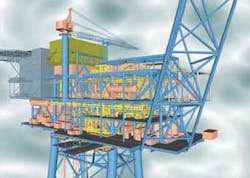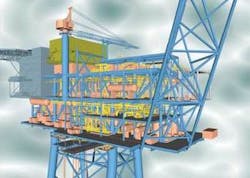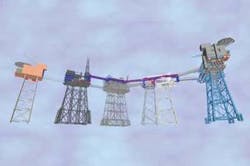Major overhaul on Valhall to sustain output through 2050
Centralized platform to replace existing set-up
Nick Terdre,Contributing Editor
BP’s Valhall Redevelopment Project will allow the North Sea field, already in its 24th year of production, to remain in service until around 2050. Offshore operations will be reconfigured around a new production and accommodation platform which is currently being engineered. If all goes well, the plan for development and operation (PDO) will be submitted to the government by the end of 2006.
Valhall, which BP acquired when it took over Amoco in the late 1990s, is situated in the southern reaches of the Norwegian sector, and like the nearby Ekofisk field, has a chalk reservoir. Optimizing recovery in this type of setting requires patience, but BP, like Ekofisk operator ConocoPhillips, is in for the long haul.
Valhall was discovered in 1975 and brought onstream in 1982. Oil in place is estimated at around 3 Bbbl. Recoverable resources in the original development plan were estimated at 250 MMbbl, equivalent at the time to 14% recovery. However, the recovery factor has been continually improved over time, and BP now says that about 500 MMbbl have been produced and the same volume remains to be recovered. But ultimately, the company hopes to extract 1.5-2 Bbbl.
In addition to optimizing recovery, Valhall Redevelopment has been driven by a second consideration - subsidence of the reservoir as hydrocarbons are produced, another feature shared with Ekofisk. Valhall’s present rate of subsidence is more than 20 cu m a year, and at some point action would be needed to safeguard the three original platforms at the field center.
However, under the redevelopment project, operations on these platforms will be phased out over the next decade and transferred to the brand new platform, designated Valhall PH. The PH jacket features an additional 10-m clearance, to ensure a sufficient air gap over the course of its 40-year design life. The new process and hotel platform will be bridge-linked to the water injection (IP) and wellhead platforms (WP), and all three will remain in place for the life of the field.
Opting for a new platform also avoids the need for expensive and extensive upgrading and modification work to keep the original installations - which are approaching the end of their original design life - in line with regulatory requirements.
The vision for the redevelopment project encompasses a safe, intelligent, maintenance-free and remotely-operated facility. BP already uses integrated operations on Valhall, mainly for drilling operations, but intends to extend this approach to cover some of the production and maintenance activities. Valhall is already designated as one of the company’s “fields of the future,” in addition to employing 4C seismic as a key reservoir management tool. It was also the first Norwegian field to feature a seismic receiver array permanently installed on the seabed.
BP is now concentrating on completing the front-end engineering design for the new platform, according to project director Ewen Drummond. This will provide the basis for a properly costed and scheduled plan which will be submitted later this year to Valhall partners Hess, Shell, and Total. Assuming all the partners sanction it, the PDO will be submitted to the oil and energy ministry before year-end.
The new platform concept will take four-five years to complete and be ready to come into operation. The capital investment will be over NOK 10 billion (around $1.6 billion), according to Drummond, which means the project will require approval from Norway’s parliament, the Storting.
Valhall PH will be the largest fixed installation in the Norwegian sector for several years. It will have a 16,000-metric ton topside supported on a 7,500-metric ton jacket. Processing capacity will be available for up to 150,000 b/d of oil, 200,000 b/d of liquids, and 5 MMcm/d of gas. Although the PH facility will be highly automated, accommodation will be provided for 150 personnel who will still be required to support the other central and flank facilities.
FEED work has been under way since the middle of last year. The project is complicated by the combination of greenfield and brownfield activities, Drummond says. In addition to the new platform, significant modifications are needed to the existing facilities, not only on the topsides but also subsea, to tie incoming and export pipelines into the new platform. Wood Group is managing FEED for the Valhall PH, with the participation of its subsidiary Mustang Engineering. J P Kenny, also part of Wood Group, is handling work on subsea tie-ins, with brownfield modifications contracted to Fabricom.
The design strategy for the platform is essentially a development of that employed for the recent Clair phase 1 development in the UK sector, which followed Gulf of Mexico practices, Drummond says. Instead of contracting one yard to fabricate and assemble all the major topsides modules, the work is divided into smaller template and skid-based units, or pre-assembled units, which can be built by smaller as well as larger yards. Altogether there will be some 40 skids weighing from a few dozen metric tons up to several hundred metric tons. Wood Group and Mustang also performed the topsides FEED for Clair.
Vendor/cost considerations
The design philosophy calls for design to be taken to approved-for-construction status before fabrication begins, Drummond says. This entails having input from vendors, which also serves to firm up cost estimates. In addition to the skid packages, there are four main fabrication contracts: jacket; deck, including installation and hook-up of skids; accommodation module, including design; and a power-from-shore module.
Separate contracts will be awarded for installation of the jacket, topsides, accommodation module, and bridge-links; for brownfield modifications; and for subsea tie-ins.
Invitations to tender for the fabrication contracts were issued in late spring and bids received in the summer. Bids have also been submitted for the heavy-lift installation vessel. The early contracting strategy is in part aimed at securing reliable cost estimates and key design input from suppliers for inclusion in the plan submitted to the licensees. These key awards are planned to be made immediately after partner approvals and PDO submission. Other smaller awards - over 100 in total - will continue over the following months.
To meet the 40-year design life requirement there has been a close focus on material selection to reduce maintenance requirements, says project coordinator Dag Løfsgaard. As a result, the new platform will see a higher than normal use of alloyed and other exotic materials such as titanium and duplex stainless steel.
Power supply switch
The redevelopment project will also bring a new approach to power supply. At present the field facilities are operated with power generated on the field by gas turbines. These will be replaced with a 292-km power link direct from the shore - an unprecedented distance for an offshore installation. The main contracts for the system were awarded earlier this year to ABB Power Technologies for the converter stations, and to Nexans Norway for the subsea cable, which will be installed in two parts.
The scheme involves taking power in the form of alternating current at 300 kV from the national grid, converting it to high voltage direct current (HVDC), and transmitting it at 150 kV through a subsea power cable to the new platform, where it will be converted back to AC at 11 kV for use on the field. The total power requirement is 78 MW.
The solution is not only cost-effective but offers clear environmental benefits - at peak it will eliminate an annual 300,000 metric tons of CO2 and 250 tons of nitrogen oxide, when compared with a combined cycle power plant operating with low NOx gas turbines. Grid power in Norway is for the most part clean power generated by hydro-electric plants.
Eliminating CO2 output will also cut costs, as such emissions from offshore installations are taxed in Norway. Further benefits are that ABB’s HVDC Light system offers very high availability - 98.5-99% - and has a much lower maintenance requirement than gas turbines.
An onshore converter station will be built at Lista near Norway’s southern tip, and conversion of the HVDC power on the platform will take place in a dedicated module weighing about 1,000 metric tons.
Fiber-optic bundle
Nexans’ delivery also includes a fiber-optic cable, which will be bundled with the power cable for installation purposes. The two cables will be buried to protect them from fishing and other marine activities. Valhall is already linked to the mainland by a fiber-optic cable, but the second cable will provide the redundancy needed to move the central control room into the integrated operation environment (IOE) at BP’s Stavanger headquarters. A back-up intervention room will be established offshore which will be fully equipped to take over control in case of emergencies.
Maintaining reservoir pressure through water injection is standard practice for enhancing oil recovery, but in the case of a chalk reservoir it also helps to slow subsidence, at least in the long term. In the period following the introduction of water injection, as ConocoPhillips can testify on Ekofisk, subsidence can be temporarily accelerated. This is a possibility which BP also has to be prepared for, says Løfsgaard.
Valhall PH will be the sixth platform at the field center. The original complex consisted of three platforms: quarters (QP), drilling (DP) and production/compression (PCP), bridge-linked in that order. In 1996 a new wellhead platform (WP) with 19 slots was added, which is bridge-linked to PCP. This was followed in 2002/03 by a water injection platform (IP), which has 23 slots and is bridge-linked to WP. Valhall PH will itself be bridge-linked to IP.
Two wellhead platforms, Valhall South Flank and Valhall North Flank, each with 21 slots, have also been installed on the flanks of the field. Each is located six to seven km from the central complex and connected to it by a 10-in. flowline, 1.6 MW power cable and fiber-optic control cable. The Hod satellite 14 km to the south is also tied back to Valhall. Oil from Valhall is exported by a 38 km pipeline from PCP to Ekofisk and gas by a 24 km line from WP to the Norpipe line. With the exception of the gas export line, all these lines will be re-routed to PH.
The new platform will take over the functions both of PCP and QP, as well as solids handling on DP. Activities on PCP and QP will cease once PH is in full swing, and the two redundant platforms will then be placed in a cold state. Production through DP is expected to continue until the mid 2010s. When it is no longer economic, the wells will be shut in and the platform deactivated. Plans will then be drawn up for decommissioning these three platforms.
Production from Valhall is currently around 80,000 b/d, though following the redevelopment, it should increase, as indicated by the new platform’s production capacity. Further production wells are planned, both at WP and at the flanks, where a first phase of drilling by jackupWest Epsilon finished earlier this year. There will also be continuous activity in drilling water injection wells for some years to come. Only one is in operation on IP so far, and one on WP. A continual build-up in water injection - full injection capacity on IP is 220,000 b/d - will be one of the drivers for increased production once the redevelopment is in place.


